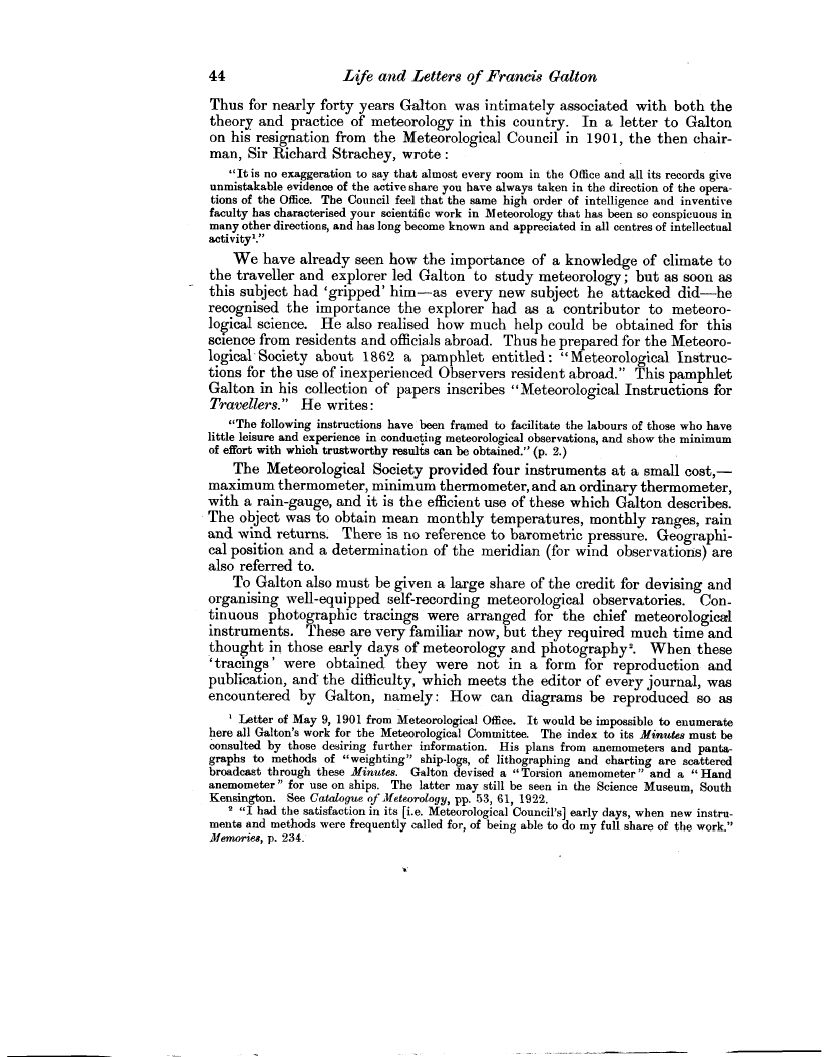44 Life and Letters of Francis Galton
Thus for nearly forty years Galton was intimately associated with both the theory and practice of meteorology in this country. In a letter to Galton on his resignation from the Meteorological Council in 1901, the then chairman, Sir Richard Strachey, wrote
"It is no exaggeration to say that almost every room in the Office and all its records give unmistakable evidence of the active share you have always taken in the direction of the operations of the Office. The Council feel that the same high order of intelligence and inventive faculty has characterised your scientific work in Meteorology that has been so conspicuous in many other directions, and has long become known and appreciated in all centres of intellectual
activity'."
We have already seen how the importance of a knowledge of climate to the traveller and explorer led Galton to study meteorology ; but as soon as this subject had `gripped' him-as every new subject he attacked did-he recognised the importance the explorer had as a contributor to meteorological science. He also realised how much help could be obtained for this science from residents and officials abroad. Thus he prepared for the Meteorological' Society about 1862 a pamphlet entitled : "Meteorological Instructions for the use of inexperienced Observers resident abroad." This pamphlet Galton in his collection of papers inscribes "Meteorological Instructions for Travellers." He writes:
"The following instructions have been framed to facilitate the labours of those who have little leisure and experience in conducting meteorological observations, and show the minimum of effort with which trustworthy results can be obtained." (p. 2.)
The Meteorological Society provided four instruments at a small cost,maximum thermometer, minimum thermometer, and an ordinary thermometer, with a rain-gauge, and it is the efficient use of these which Galton describes. The object was to obtain mean monthly temperatures, monthly ranges, rain and wind returns. There is no reference to barometric pressure. Geographical position and a determination of the meridian (for wind observations) are also referred to.
To Galton also must be given a large share of the credit for devising and organising well-equipped self-recording meteorological observatories. Continuous photographic tracings were arranged for the chief meteorological instruments. These are very familiar now, but they required much time and thought in those early days of meteorology and photography2. When these tracings' were obtained they were not in a form for reproduction and publication, and the difficulty, which meets the editor of every journal, was encountered by Galton, namely : How can diagrams be reproduced so as
' Letter of May 9, 1901 from Meteorological Office. It would be impossible to enumerate here all Galton's work for the Meteorological Committee. The index to its Minutes must be consulted by those desiring further information. His plans from anemometers and panta
graphs to methods of "weighting" ship-logs, of lithographing and charting are scattered broadcast through these Minutes. Galton devised a "Torsion anemometer" and a "Hand anemometer " for use on ships. The latter may still be seen in the Science Museum, South Kensington. See Catalogue of Meteorology, pp. 53, 61, 1922.
2 "I had the satisfaction in its [i.e. Meteorological Council's] early days, when new instruments and methods were frequently called for, of being able to do my full share of the work." JNemoriea, p. 234.

